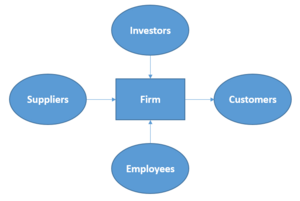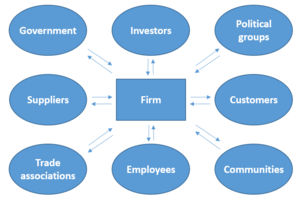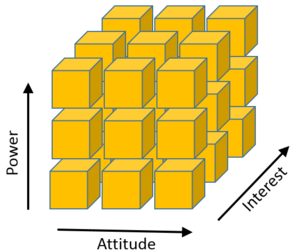Stakeholder Analysis
| Line 112: | Line 112: | ||
==Why mapping stakeholders== | ==Why mapping stakeholders== | ||
Mapping stakeholders can be seen as the central part of the stakeholder analysis because it creates an insight in the comparison between different essential parameters, and thereby creates a tool that can be used for determine level of support, predict behaviour and shape engagement plan. | Mapping stakeholders can be seen as the central part of the stakeholder analysis because it creates an insight in the comparison between different essential parameters, and thereby creates a tool that can be used for determine level of support, predict behaviour and shape engagement plan. | ||
| + | |||
| + | develop own | ||
==Types of maps== | ==Types of maps== | ||
Several types of stakeholder maps are described in the literature, many comparing two or three parameters that gives an indication of the criticality of the stakeholders. | Several types of stakeholder maps are described in the literature, many comparing two or three parameters that gives an indication of the criticality of the stakeholders. | ||
| + | |||
| + | The following subsections introduces a central selection of stakeholder maps. | ||
===Power/Interest diagram=== | ===Power/Interest diagram=== | ||
| − | |||
| − | |||
| − | |||
| − | + | ===Interest/Influence diagram=== | |
| − | + | ||
| + | ===3D mapping=== | ||
[[File:3D_map_vers2.PNG|300px|thumb|right|Figure 3: 3D mapping visualised as 3x3 matrix.]] | [[File:3D_map_vers2.PNG|300px|thumb|right|Figure 3: 3D mapping visualised as 3x3 matrix.]] | ||
| + | |||
| + | Could also be bobble chart | ||
| + | |||
| + | ===Stakeholder Circle=== | ||
| + | |||
| + | ===Affected/Affecting=== | ||
| + | |||
=Challenges and uncertainty= | =Challenges and uncertainty= | ||
Revision as of 00:59, 25 November 2014
Contents |
Introduction
According to the ISO 21500 standard [1] a stakeholder is defined as:
Person, group or organization that has interests in, or can affect, be affected by, or perceive itself to be affected by, any aspect of the project.
Many other versions of this definition can be found in the literature but in general containing the same content. It is important to distinguish between shareholder and stakeholder, and understand that stakeholder analysis includes analysis of the shareholders but also takes all other stakeholders into consideration.
Figure 1 shows a classic input/output model with suppliers, investors and employees that provide an input so the firm can generate an output to the customers. Figure 2 shows stakeholder model where the firm are interacting with several stakeholders. The transformation from Figure 1 to Figure 2 illustrates the difference of a shareholder and stakeholder approach.
Management of a projects, programs or portfolios happens to be complex and require an extensive overview of several aspects and constraints. But in order to act appropriate and create sustainability the management often has to consider these aspects and constraints not only from their own point of view but also from a number of other stakeholders views.
It is important for the management to know who their stakeholders are and there characteristics in relation to the project, program or portfolio. This might be their influence, impact, interest, attitude etc.
In stakeholder analysis all stakeholders first have to be identified and relevant information gathered. The stakeholders are then mapped based on relevant parameters. Some of the most typical parameters when mapping are power, interest and influence, which is often visualised in a 2D diagram. The map gives an overview of the stakeholders and can be foundation for planning how to deal with stakeholders.
Benefits
Among others Zhang (2011)[2] argues that a stakeholder approach consider a long-term development strategy for the company/organisation while a shareholder approach focus on short-term profit.
The stakeholder analysis will give a solid foundation for decision making and strategy development. Several element in execution can benefit from the stakeholder analysis since initiatives can be shaped more appropriate.
Stakeholders being engaged appropriate will help the company/organisation obtain a better reputation among the stakeholder, which typical will have a boomerang effect and can also create value on the company´s/organisations goodwill account.
Another account where value can be put in is CSR. Engaging stakeholder can directly be seen as increasing focus on corporate social responsibility.
Background
In 1932 Dodd started one of the first arguments that a company should not only focus on shareholders but also consider the entire spectra of stakeholders when managing a company[3]. However Dodd did not use the term stakeholder since this was not developed within this field of study yet. The term stakeholder arose in the first half of the 1960´s. Among others Freeman (1984)[4] are crediting an internal memorandum from Stanford Research Institute in 1963 for being the first to apply the term Stakeholder in this field of the literature. In 1995 Donaldson and Preston [5] described their view on stakeholder theory as the existence of three types:
- Instrumental stakeholder theory argues that companies/organisations that take stakeholders into consideration will benefit from doing so.
- Descriptive stakeholder theory is just stating that the company/organisation have stakeholders and that there they should analyse not only the shareholders but all stakeholders.
- Normative stakeholder theory evaluates why a company/organisation should take their stakeholders into consideration.
Baker and Nofsinger (2012)[6] use Coca-Cola for examplifing the three types of stakeholder theory:
- An instrumental stakeholder theorist might say: Coca-Cola should manage its water policies so as to minimize the negative impact of reputation effects on firm value.
- A descriptive stakeholder theorist might say: Coca-Cola´s water policies are an important defining characteristic of the firm.
- A normative stakeholder theorist might say: Coca-Cola has a duty to protect the environment, so it should pay more attention to its water policies.
All three theories are used in stakeholder analysis depending on need and interest. Different companies/organisation will use different approaches.
Process
In the literature several description of stakeholder analysis processes can be found and most large companies/organisations will have their own definition of the process. They generally follow this structure:
- A: Identify stakeholders
- B: Analyse stakeholders
- C: Engage stakeholders
Cleland (1994)[7] states a typical process:
- 1: Identify stakeholders
- 2: Gather information on stakeholders
- 3: Identify stakeholders priorities
- 4: Determine stakeholders strengths and weaknesses
- 5: Identify stakeholder support
- 6: Predict stakeholder behaviour
- 7: Prepare stakeholder management strategy
The identification of stakeholders could be done by brain storming. Typical stakeholders are:
- Employees
- Shareholders
- Media
- Suppliers
- Government
- Customers
- Community
- Managers
- Directors
- Competitors
- Sponsors
- Consumers
The list will typical also include a handful of more specific stakeholders depending on situation. The stakeholders can also be identified in a more detailed manner - fx. by different departments within the company/organisation if they fx. have different interest.
It will often make sense to identify which stakeholders are key stakeholders. The definition of a key stakeholder vary depending on type of project, programme or portfolio. Key stakeholders might by identified when mapping the stakeholders as described below.
When gathering information it is important to act neutral and not mix the collecting of information with the analysis it self.
Identifying the stakeholders priorities is the first step of the more in depth analysis. Priorities will often include cost, schedule and quality and can fx. be measured on a 3 level scale: 1.Acceptable, 2.Adaptable; 3.Not acceptable.
Determine stakeholders strengths and weaknesses - or do a complete SWOT inventory will often be a beneficial part of the stakeholder analysis. The SWOT for the stakeholders will consist of determine the following elements:
- Strength: What are the stakeholders specialities and forces? How can this strengthen the project/programme/portfolio?
- Weaknesses: In which area does the stakeholder not excel? To what degree can this weaken the project/programme/portfolio?
- Opportunities: Which beneficial situations and options can the stakeholder possible experience? How can the project/programme/portfolio benefit from this opportunity?
- Threads: Which challenges and difficulties can be seen from the stakeholder perspective? Will this develop into a thread for the project/programme/portfolio?
It is always important to know your friends. And that is what identifying stakeholder support is about. It is of course good to know who are supporting and who are opposing the project/programme/portfolio in general. But it might also be relevant to consider specific scenarios or stages in the project/programme/portfolio where the support-opposing ratio will change. Fx. if you are a citizen living close construction of a new metro station. Then you will have several opposes during the noisy and dusty construction works, but you will probably support the project when it is completed and you have a new metro station next door.
Analysing the stakeholdes support and role in different phases and situations also leads to predicting the stakeholders behaviour. But for doing this prediction other factor might also have to be considered - fx. power, interest and influence. This is typically analysed by mapping the stakeholders, which will be discussed in the section below.
Preparation stakeholder management strategy is about how to engage the stakeholdes in the project/programme/portfolio in an appropriate way. This can result in creating an engagement plan that will not only contain engagement actions but also in which phase of the project/programme/portfolio the actions shall be applied.
As a tool for combining the analysis a stakeholder table and map are often created. A stakeholder table can typically contain:
- Stakeholder name.
- Category - fx. internal, authorities or end users.
- Relation
- Role
- Priorities
- SWOT
- Engagement plan
The table will then act as an overview of the analysis. The mapping of stakeholders will be discussed in the section below.
Mapping stakeholders
Why mapping stakeholders
Mapping stakeholders can be seen as the central part of the stakeholder analysis because it creates an insight in the comparison between different essential parameters, and thereby creates a tool that can be used for determine level of support, predict behaviour and shape engagement plan.
develop own
Types of maps
Several types of stakeholder maps are described in the literature, many comparing two or three parameters that gives an indication of the criticality of the stakeholders.
The following subsections introduces a central selection of stakeholder maps.
Power/Interest diagram
Interest/Influence diagram
3D mapping
Could also be bobble chart
Stakeholder Circle
Affected/Affecting
Challenges and uncertainty
Analysing stakeholders can be an extensive task. The amount of stakeholders, depending on circumstances and level of detail, will typically be between 15 and 50. The analysis will therefore require a significant amount of work.
When gathering information about the stakeholders, it might not be possible to collect all information by contacting stakeholders. It will therefore be necessary to assume some conditions, which for specific stakeholders can result in an analysis with limited robustness.
As discussed earlier their will typically be both supporters and opponents. And it might turn out that one have to handle unpopular communication with opponents.
References
- ↑ ISO21500. 2012. Guidance on Project Management. International Organization for Standardization.
- ↑ Zhang, Yanru. 2011. “The Analysis of Shareholder Theory and Stakeholder Theory”. Proceedings - 2011 4th International Conference On Business Intelligence and Financial Engineering, Bife 2011, Proc. - Int. Conf. Bus. Intell. Financ. Eng., Bife: 90-92.
- ↑ Dodd Jr., E. Merrick. 1932. “For Whom Are Corporate Managers Trustees?”. Harvard Law Review 45 (7): 1145.
- ↑ Freeman, R,E. 1984. Strategic Management: A Stakeholder Approach. Boston, MA: Pitman.
- ↑ Donaldson, T., and LE Preston. 1995. “The stakeholder theory of the corporation - Concepts, evidence and implications”. Academy of management review 20 (1): 65-91.
- ↑ Baker, H. Kent., and John R. Nofsinger. 2012. Socially Responsible Finance and Investing : Financial Institutions, Corporations, Investors, and Activists. Wiley.
- ↑ Cleland, David. 1994. Project Management: Strategic Design and Implementation. McGraw-Hill Inc.
- ↑ Template:Cite book
Further reading
- Reed, Mark S., Anil Graves, Norman Dandy, Helena Posthumus, Klaus Hubacek, Joe Morris, Christina Prell, Claire H. Quinn, and Lindsay C. Stringer. 2009. “Who'S In and Why? A Typology of Stakeholder Analysis Methods For Natural Resource Management”. Journal of environmental management 90 (5): 1933-1949.


